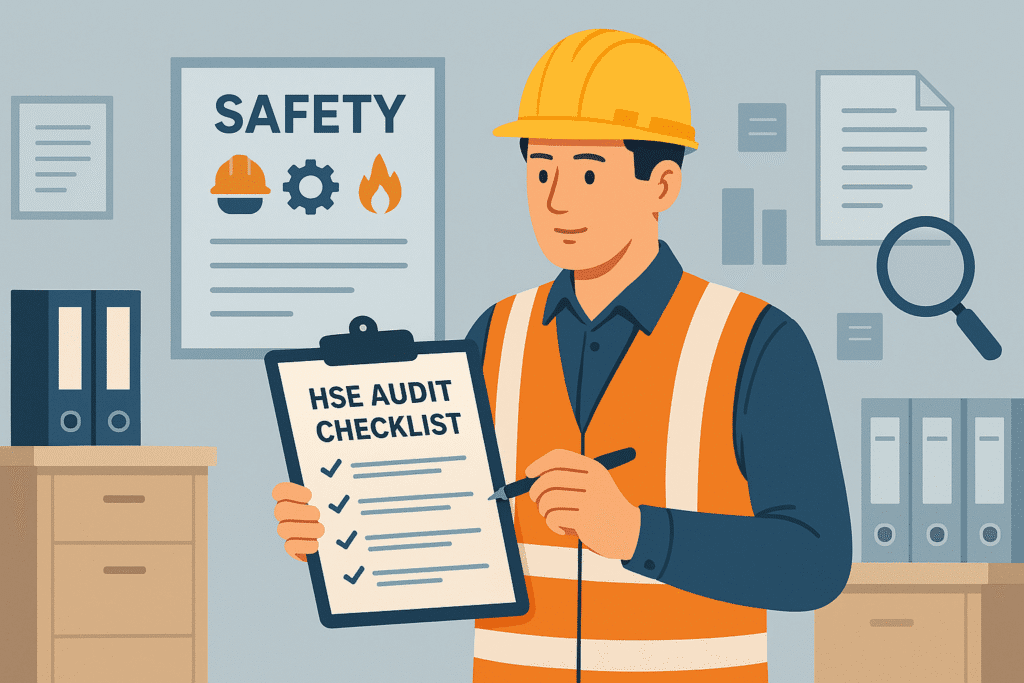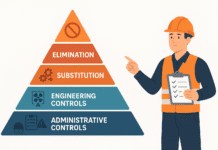
How to Conduct an Internal HSE Audit | Checklist Included
A well-planned Internal HSE Audit is the backbone of a strong safety management system. It helps organizations verify compliance with HSE policies, identify gaps, and implement corrective actions before external audits or incidents occur.
Conducting an internal audit isn’t just about checking boxes — it’s about building a culture of continuous improvement, accountability, and proactive risk control.
In this complete guide, you’ll learn:
- What an Internal HSE Audit is
- Its importance and objectives
- Step-by-step process for conducting an audit
- Common areas to review
- How to prepare and report audit findings
- A free HSE audit checklist template
What is an Internal HSE Audit?
An Internal HSE Audit is a systematic, independent, and documented process used to evaluate how well an organization’s health, safety, and environmental management system is performing against established standards, procedures, and regulations.
Definition
“An internal HSE audit is an independent review to verify the compliance, effectiveness, and continual improvement of an organization’s Health, Safety, and Environment (HSE) Management System.”
Unlike external audits (conducted by clients, certification bodies, or regulators), internal audits are done by in-house trained personnel to ensure ongoing compliance.
Objectives of an Internal HSE Audit
The main goals of conducting an internal audit include:
- Assess compliance with HSE laws, standards (like ISO 45001, ISO 14001), and company policies.
- Evaluate the effectiveness of the HSE Management System.
- Identify non-conformities and potential areas of risk.
- Recommend improvements and corrective actions.
- Prepare the organization for client or certification audits.
- Enhance safety culture through transparency and accountability.
Types of HSE Audits
| Type of Audit | Purpose | Frequency |
|---|---|---|
| Internal Audit | Evaluate internal systems and compliance | Quarterly / Half-Yearly |
| External Audit | Conducted by clients, certifiers, or regulators | Annually / As required |
| Compliance Audit | Ensure adherence to legal standards | Annually |
| Process / Activity Audit | Review specific operations (e.g., Hot Work, Confined Space) | As needed |
| Follow-Up Audit | Verify closure of previous findings | After corrective actions |
Benefits of Internal HSE Audits
✔ Ensures continuous compliance and improvement.
✔ Reduces accidents, incidents, and downtime.
✔ Identifies training and resource needs.
✔ Strengthens company reputation during client audits.
✔ Builds employee awareness and accountability.
✔ Supports certification (ISO 45001, ISO 14001, ISO 9001).
Step-by-Step Procedure for Conducting an Internal HSE Audit
Conducting an internal audit requires planning, teamwork, and a structured approach.
Below are the eight key steps to perform an effective internal HSE audit:
Step 1: Define the Audit Scope and Objectives
Determine what will be audited, where, and why.
Scope examples:
- Entire site or specific departments (e.g., Maintenance, Warehouse, or Construction).
- Particular systems (Permit-to-Work, Training, Waste Management).
Objectives examples:
- Evaluate compliance with ISO 45001 or company HSE policy.
- Verify that risk assessments and permits are up to date.
Tip: Define clear scope boundaries to avoid overlap or confusion.
Step 2: Develop the Audit Plan
A detailed Audit Plan ensures a smooth and systematic process.
Include:
- Audit schedule (dates and time).
- Areas/departments to be covered.
- Assigned auditors and responsibilities.
- Checklists or criteria to be used.
Example:
| Date | Department | Auditor | Focus Area |
|---|---|---|---|
| 20 Jan | Workshop | Safety Officer | Machinery & PPE |
| 21 Jan | Stores | HSE Manager | Chemical Handling |
| 22 Jan | Construction Area | Lead Auditor | Permit-to-Work & Fire Safety |
Tip: Communicate the plan to all departments before the audit to ensure cooperation.
Step 3: Prepare the Audit Checklist
The HSE Audit Checklist serves as a guide for auditors to ensure all critical areas are reviewed.
Checklist sections may include:
- Policy and leadership
- Legal compliance
- Risk assessment and control measures
- Training and competency
- Emergency preparedness
- Housekeeping
- Fire and electrical safety
- Waste and environmental management
A full sample checklist is included at the end of this article.
Step 4: Conduct the Audit (Field Verification)
This is the most crucial step. The audit team visits the site to observe, verify, and record findings.
Key actions:
- Inspect work areas for compliance with safety procedures.
- Check documentation (permits, logs, risk assessments).
- Interview workers and supervisors to gauge safety awareness.
- Verify that controls identified in HIRA are being implemented.
Tip: Use the “Observe – Ask – Verify” approach:
- Observe the task
- Ask the worker about procedures
- Verify records and evidence
Step 5: Record Non-Conformities (NCs) and Observations
Findings should be categorized as:
- Major Non-Conformity: Significant deviation from standards or legal breach.
- Minor Non-Conformity: Partial or isolated non-compliance.
- Observation: Potential improvement area, not a direct violation.
Example:
| Finding Type | Description | Evidence | Risk Level |
|---|---|---|---|
| Major NC | No fire extinguisher near diesel tank | Site inspection | High |
| Minor NC | Outdated safety signage | Audit observation | Medium |
| Observation | Improve housekeeping in laydown area | Visual | Low |
Tip: Always record objective evidence (photo, document, interview).
Step 6: Conduct the Closing Meeting
After completing the audit, the audit team meets with department heads and supervisors to:
- Present findings and evidence.
- Discuss immediate corrective actions.
- Agree on timelines for closure.
Key Principle:
The closing meeting must be constructive, not confrontational. The goal is to improve, not to blame.
Step 7: Prepare the Audit Report
A well-written audit report communicates findings clearly to management.
Include:
- Audit objectives and scope.
- Methodology and checklist used.
- Summary of findings and ratings.
- Corrective and preventive actions (CAPA).
- Responsibilities and target completion dates.
Tip: Use a color-coded summary:
- 🟥 High Risk (Immediate Action)
- 🟧 Medium Risk (Within 30 days)
- 🟩 Low Risk (Monitor & Improve)
Step 8: Follow-up and Verification
Follow-up ensures that corrective actions have been implemented effectively.
Follow-up Activities:
- Site re-verification.
- Review of updated records or photos.
- CAPA closure sign-off by auditor.
Without follow-up, audits lose their effectiveness.
Tip: Use a tracking sheet for CAPA closure.
Key Areas to Audit in an HSE Management System
An effective internal audit should cover the following HSE components:
| Audit Element | Key Focus Areas |
|---|---|
| Leadership & Policy | HSE policy, management commitment, responsibilities |
| Legal & Compliance | National regulations, licenses, permits |
| Risk Assessment | HIRA, JSA, Permit-to-Work, review frequency |
| Training & Competence | Training records, refresher schedule |
| Incident Management | Reporting, investigation, root cause analysis |
| Emergency Preparedness | Fire drills, evacuation plan, emergency contacts |
| Health & Hygiene | Occupational health checks, PPE, welfare facilities |
| Environment | Waste disposal, emissions, spill control |
| Contractor Safety | Induction, supervision, PPE compliance |
| Inspection & Maintenance | Equipment logs, calibration, preventive maintenance |
| Documentation & Records | HSE manual, SOPs, audits, reports |
| Continuous Improvement | Review meetings, KPI tracking |
Sample Internal HSE Audit Checklist
| Sl. No. | Audit Item | Compliance (Yes/No) | Remarks |
|---|---|---|---|
| 1 | HSE policy displayed and communicated to employees | ||
| 2 | Risk assessments conducted and updated regularly | ||
| 3 | Safety training records maintained and verified | ||
| 4 | PPE available and used properly | ||
| 5 | Permit-to-Work procedures implemented correctly | ||
| 6 | Fire extinguishers inspected and tagged | ||
| 7 | Emergency exits unobstructed and marked | ||
| 8 | Waste segregation and disposal practices followed | ||
| 9 | First aid facilities maintained and accessible | ||
| 10 | Incident reporting and investigation system in place |
Common Mistakes to Avoid During an HSE Audit
- Conducting audits without a defined scope.
- Using outdated checklists.
- Focusing only on documentation — ignoring field realities.
- Lack of trained auditors or bias in evaluation.
- Not closing previous audit findings.
- Treating audits as a fault-finding exercise.
- Failing to track CAPA implementation.
Tip: Always use the “Audit for Improvement, not Inspection for Fault” mindset.
Audit Scoring Example
| Score Range | Rating | Interpretation |
|---|---|---|
| 90–100% | Excellent | Fully compliant and well implemented |
| 75–89% | Good | Minor improvements needed |
| 50–74% | Fair | Partial compliance, major improvements required |
| <50% | Poor | Non-compliant, immediate action required |
Follow-Up and CAPA Tracking Template
| Finding | Corrective Action | Responsible Person | Target Date | Status |
|---|---|---|---|---|
| Missing fire extinguisher near generator | Install extinguisher | Site Engineer | 10 March | Closed |
| PPE not issued to new joiners | Issue and record PPE | Store Keeper | 5 March | Open |
Tip: Conduct monthly reviews of CAPA to ensure closure and effectiveness.
Internal Links
- Safety Walkthrough vs Safety Audit
- Construction Site Risk Assessment: Key Hazards and Controls
- Common Mistakes in HIRA and How to Avoid Them
- Fire Risk Assessment in the Workplace – Complete Guide
- Incident Investigation vs Root Cause Analysis: Methodologies, Tools & Tips
External References
For checklist and templates visit The HSE Tools.
Conclusion
An Internal HSE Audit is not merely a compliance exercise — it’s a strategic tool for continuous improvement.
By following a structured approach, using the right checklist, and ensuring proper follow-up, organizations can detect weaknesses early and maintain a proactive safety culture.
“A successful audit is not one that finds no issues — it’s one that leads to meaningful improvements.”
Start your internal HSE audit today using the free checklist provided, and take a big step toward safer, smarter, and more compliant operations.






















